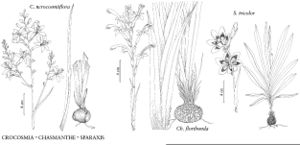Difference between revisions of "Chasmanthe floribunda"
Trans. Roy. Soc. South Africa 20: 274. 1932.
FNA>Volume Importer |
imported>Volume Importer |
||
| (6 intermediate revisions by 2 users not shown) | |||
| Line 7: | Line 7: | ||
|year=1932 | |year=1932 | ||
}} | }} | ||
| − | |basionyms={{Treatment/ID/ | + | |special_status={{Treatment/ID/Special_status |
| + | |code=I | ||
| + | |label=Introduced | ||
| + | }}{{Treatment/ID/Special_status | ||
| + | |code=F | ||
| + | |label=Illustrated | ||
| + | }} | ||
| + | |basionyms={{Treatment/ID/Basionym | ||
|name=Antholyza floribunda | |name=Antholyza floribunda | ||
|authority=Salisbury | |authority=Salisbury | ||
| + | |rank=species | ||
| + | |publication_title=Trans. Hort. Soc. London | ||
| + | |publication_place=1: 324. 1812 | ||
}} | }} | ||
|synonyms={{Treatment/ID/Synonym | |synonyms={{Treatment/ID/Synonym | ||
|name=Antholyza prealta | |name=Antholyza prealta | ||
|authority=Redouté | |authority=Redouté | ||
| + | |rank=species | ||
}} | }} | ||
|hierarchy=Iridaceae;Chasmanthe;Chasmanthe floribunda | |hierarchy=Iridaceae;Chasmanthe;Chasmanthe floribunda | ||
| Line 29: | Line 40: | ||
|elevation=0–100 m | |elevation=0–100 m | ||
|distribution=Calif.;South Africa. | |distribution=Calif.;South Africa. | ||
| − | |discussion=<p>Chasmanthe floribunda has escaped from gardens and has become naturalized locally. It is native to the winter-rainfall region of South Africa. The species has been confused in North America with C. aethiopica (Linnaeus) N. E. Brown, which has similar flowers but is a smaller plant with unbranched stems, normally flowering in the early winter months.</p> | + | |introduced=true |
| + | |discussion=<p><i>Chasmanthe floribunda</i> has escaped from gardens and has become naturalized locally. It is native to the winter-rainfall region of South Africa. The species has been confused in North America with C. aethiopica (Linnaeus) N. E. Brown, which has similar flowers but is a smaller plant with unbranched stems, normally flowering in the early winter months.</p> | ||
|tables= | |tables= | ||
|references= | |references= | ||
| Line 38: | Line 50: | ||
-->{{#Taxon: | -->{{#Taxon: | ||
name=Chasmanthe floribunda | name=Chasmanthe floribunda | ||
| − | |||
|authority=(Salisbury) N. E. Brown | |authority=(Salisbury) N. E. Brown | ||
|rank=species | |rank=species | ||
| Line 53: | Line 64: | ||
|publication title=Trans. Roy. Soc. South Africa | |publication title=Trans. Roy. Soc. South Africa | ||
|publication year=1932 | |publication year=1932 | ||
| − | |special status= | + | |special status=Introduced;Illustrated |
| − | |source xml=https:// | + | |source xml=https://bitbucket.org/aafc-mbb/fna-data-curation/src/2e0870ddd59836b60bcf96646a41e87ea5a5943a/coarse_grained_fna_xml/V26/V26_830.xml |
|genus=Chasmanthe | |genus=Chasmanthe | ||
|species=Chasmanthe floribunda | |species=Chasmanthe floribunda | ||
Latest revision as of 22:17, 5 November 2020
Plants 60–120 cm; corm depressed-globose, 40–70 mm diam. Stems 1–2-branched. Leaves 8–10, mostly basal, basal longer than cauline; blade lanceolate, ± reaching base of spike, 18–35 mm wide. Spikes 25–40-flowered; outer spathe 13–15 mm, apex obtuse to truncate; inner ± equaling outer, apex bifurcate; flowers distichous. Tepals: perianth tube 35–45 mm, 9–12 mm proximally, often twisted, ca. 40 mm distally, base pouched; dorsal tepal horizontal, 28–33 × 7–9 mm, much exceeding others; lateral tepals patent or recurved, 12–15 × 4–7 mm; lower median tepal slightly smaller than laterals; filaments 50–55 mm; anthers 7–8 mm; ovary 6–9 mm, style branching shortly below and opposite to anthers (or exceeding them); branches 7–10 mm. Capsules 10–15 mm. Seeds 5–7 mm diam.
Phenology: Flowering mostly Feb–May.
Habitat: Road verges, grassy slopes
Elevation: 0–100 m
Distribution
Introduced; Calif., South Africa.
Discussion
Chasmanthe floribunda has escaped from gardens and has become naturalized locally. It is native to the winter-rainfall region of South Africa. The species has been confused in North America with C. aethiopica (Linnaeus) N. E. Brown, which has similar flowers but is a smaller plant with unbranched stems, normally flowering in the early winter months.
Selected References
None.
